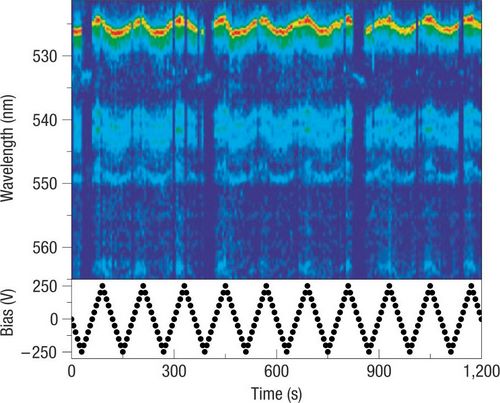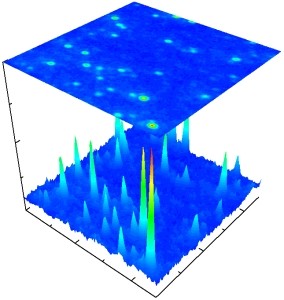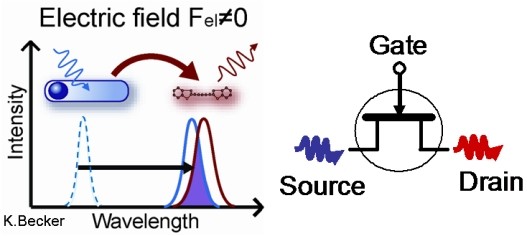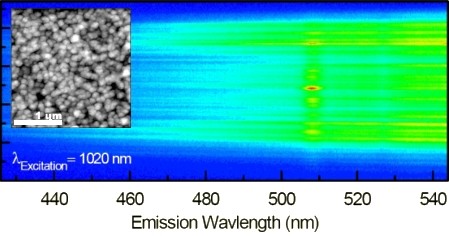Research Fields
Here, you will find a summary and a brief description of all of our currently active areas of research. For more detailed information on our work, please check our publications page or contact us directly.

Physics of pi-conjugated polymers
Pi-conjugated polymers are widely used in organic electronics. However, analyzing these materials is difficult because of their random structure in terms of length and composition of the polymer chains. Single-molecule spectroscopy allows to characterize the materials from the bottom up.

Low temperature single polymer chain spectroscopy

Here, our research aims to investigate the optical and electronic properties of polymer systems by spectroscopically studying the behavior of single polymer chains. By isolating single chains, we are able to identify the intrinsic properties of the polymer system without the interaction of neighboring polymers as would occur in the bulk.
Further, we conduct these studies under high vacuum and liquid Helium temperatures. This environment leads to a large increase in stability of the polymers as reactions with the surrounding are minimized. Such conditions allow us to probe the intrinsic properties of the polymer chains alone.

Organic semiconductors are used in a wide range of devices such as organic light-emitting diodes (OLEDs) and solar cells. Single chain spectroscopy can help us to unravel fundamental structure-property relations, in particular with regard to the role of nanoscale physical shape of the molecule. Ultimately, our studies will help to improve both the stability and the efficiency of devices.
Spectroscopy of single nanocrystals
We study the influence of colloidal shape on the emission properties of single semiconductor nanocrystals. As the dimensions of semiconductors are reduced to the size of the elementary excitation (i.e., a few nanometers), the electronic properties begin to depend strongly on shape and size.

Such quantum dots are particularly interesting for applications, e.g. as nanoscale beacons broadcasting information on the immediate environment. The unique electronic structure of single particles can be exploited in real devices, such as in fluorescence energy transfer gates. Here, the quantum dot acts as a nanoscale radio transmitter, who's resonance with an adjacent receiver can be tuned electrically.
Time resolved luminescence
We study ultrafast optical relaxation phenomena in novel molecular and colloidal systems. This allows us, e.g., to identify the presence and quantify the efficiency of the transfer of excitation energy. Energy transfer is crucial to light-harvesting in photosynthesis, and we aim to mimic this in the lab. Direct applications include tuning the emission color of organic and inorganic LEDs.
Non-linear optics of plasmonic nanostructures
Plasmonic nanostructures are commonly nanoscale metallic structures that resonantly couple with electromagnetic radiation in the form of a collective oscillation of the electrons in the metal on the particle surface. These excitations are referred to as surface plasmons, which, when localized, lead to a variety of non-linear optical effects. These include, but are not limited to:
- Second-harmonic generation,
- White-light generation,
- Third-harmonic generation, and
- Surface Enhanced Raman Scattering (SERS).
Of the above effects, SERS is one of the most interesting. Plasmonic enhancement of both the incident radiation and the Raman scattered light leads to an enhanced Raman signal of many orders of magnitude. One of our goals in this field is to gain a better understanding of SERS by correlating it with the other non-linear optical effects on a variety of different plasmonic nanostructures.

In addition to the SERS we are interested in further work on the non-linear optical phenomena from novel plasmonic structures including fractalated metal surfaces, other random nanostructures, and metal particle monomers, dimers and trimers.
Spin physics of organic semiconductors
The spin of charge carriers plays a significant role in the performance of organic semiconductor devices. For example, the ultimate efficiency of OLEDs is limited by the number of singlet excitations (i.e. excitations with antiparallel spins) that recombine in the device. In other words, only singlets decay radiatively in OLEDs, so the formation of triplets results in decreased efficiency. Consequently, spin-statistics in OLEDs plays an important role with regards to the device efficiency.
We have developed a unique technique to visualize triplet excitations in organic semiconductors. By locally amplifying spin-orbit coupling, triplets become visible as phosphorescence, an indirect radiative transition. This allows us to study spin relaxation phenomena in organic semiconductors and ultimately develop new approaches to control and exploit the spin degree of freedom in devices.



